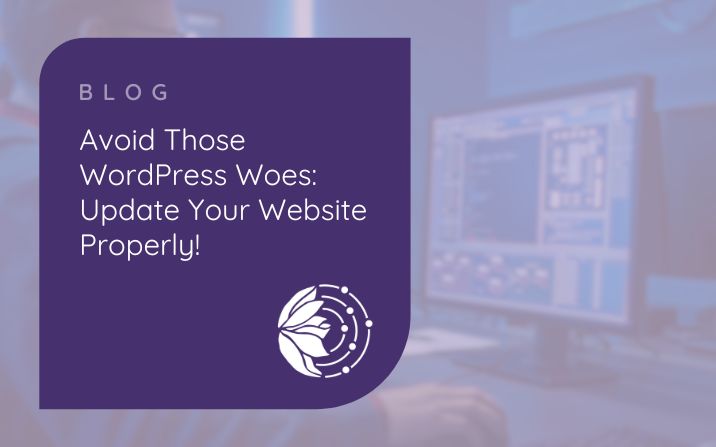WordPress is a popular choice for building a website these days. Did you know it powers 25% of all websites, and that number is rapidly growing. So, it’s little wonder why it’s so popular when you consider how flexible it is, it seamlessly integrates with search engines, and can be updated with a few clicks.
One thing that often gets forgotten, is what happens after the website has been built and gone live? Who now has the responsibility in keeping it updated and secure? If that has now fallen on you – how often are you managing to do that?
Failure to update your WordPress website could create more than a few headaches for you and your business.
Updating your WordPress website is essential if you want to keep everything running smoothly. It doesn’t matter how great the design is, or how tight the coding is behind the scenes – WordPress is vulnerable to hacking attacks when you don’t keep on top of things.
Ok, so that sounds like a major issue with WordPress. Yes, and not so much. WordPress is so popular that it’s always going to be seen as a top target for hackers. Although the core of WordPress is very secure, the problem lies with its modular nature – anyone can create a new theme or plugin, and often these have security flaws that can leave websites open to attack.
Hackers want to access your WordPress website so they can send out spam email, gain access to your data and mailing list, or to download malicious software on the computers of your visitors.
Did you know that there is a wrong way to update your website? Chances are, you log in to your admin dashboard and see the symbol for new updates. You head straight on over to the updates page, select everything, and hit update – right?
Wrong. Doing things this way can cause your entire website to glitch, or even corrupt the database rendering the entire website unusable – white screen time! Yet failure to update at all can leave you very vulnerable to being hacked.
So how do you keep your WordPress website updated correctly?
The correct order for any updates is as follows:
- Plugins should be updated first
- Themes come a close second
- WordPress itself comes last
But before you update anything you need to backup your website. BackupBuddy and Updraft Plus are easy to use and reliable plugins that take care of this for you. Make sure you store the backup copy somewhere safe that can be accessed anywhere – ideally on cloud storage.
Ok, back to the updates. Before updating any plugins, always check that the new version is compatible with the theme you’re using – if it isn’t, this is where you’re going to get glitches. Plugins are constantly being developed and updated, so it can feel like you’re updating them all the time, but if you don’t you leave yourself open to attack.
Themes are the building blocks for the design of your website, your designer will have added some coding to a theme to make your website unique and personal to you and your business. It’s always a good idea to have a ‘child’ theme on your WordPress website so that any updates to the ‘parent’ theme don’t affect any individual coding you or a designer has made to alter the appearance of your website. If you haven’t got this, get in touch and we can guide you through the process.
If you update the parent theme any changes to the coding made by you, or your website designer, will be lost – so ensure you’re using a child theme or you could end up with a completely different design!
Updating your theme is a fairly large undertaking and could cause a number of plugins to suddenly stop working, or break your website. It’s often worth waiting a few days to allow plugins to catch up with the latest themes before going ahead with an update. Going to the plugin directory and checking they are compatible is a good precaution – the most popular themes will have plugins updated for them first.
WordPress itself launches an update every few months or so. These can be to solve security vulnerabilities that have been identified, or to change functionality. Avoid updating as soon as a new update is made available (some hosting providers do this automatically so check to make sure this option is disabled with your particular website). You need to give the plugin and theme teams time to code their work to ensure compatibility with the new update – most are aware of an impending update and will be able to provide new versions within a few days.
It’s worth waiting two or three weeks before updating your version of WordPress to ensure that any problems or glitches have been ironed out before they can affect your website.
Lastly, you need to ensure you have access to the ‘back end’ of your website, ie the hosting itself. This is where the database is stored and if anything needs fixing, you need quick access to it. Some hosting providers are better than others for allowing speedy access – the last thing you want is to be stuck on the phone for hours to the other side of the world requesting access to something you’re already paying for. So check you have full access now, so you know what to do if disaster strikes in the future.
Although WordPress websites are fantastic, and easily one of the simplest and flexible ways of having a great looking site for your business, you do have to look after them. Backing up your database, and updating properly is the best way to achieve this. If you’d like to discuss how a VA can help you with the maintenance aspect of WordPress websites so you don’t have to, get in touch with us here at Banks’ Business Solutions.

